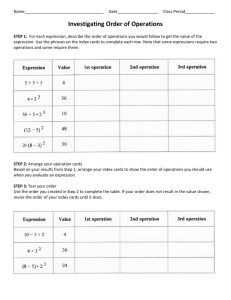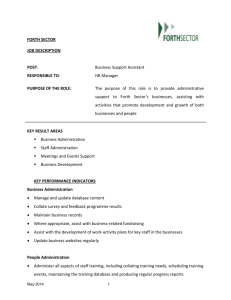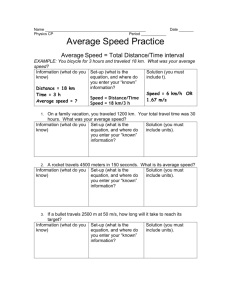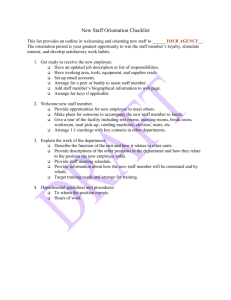Employee Orientation Guidelines
advertisement
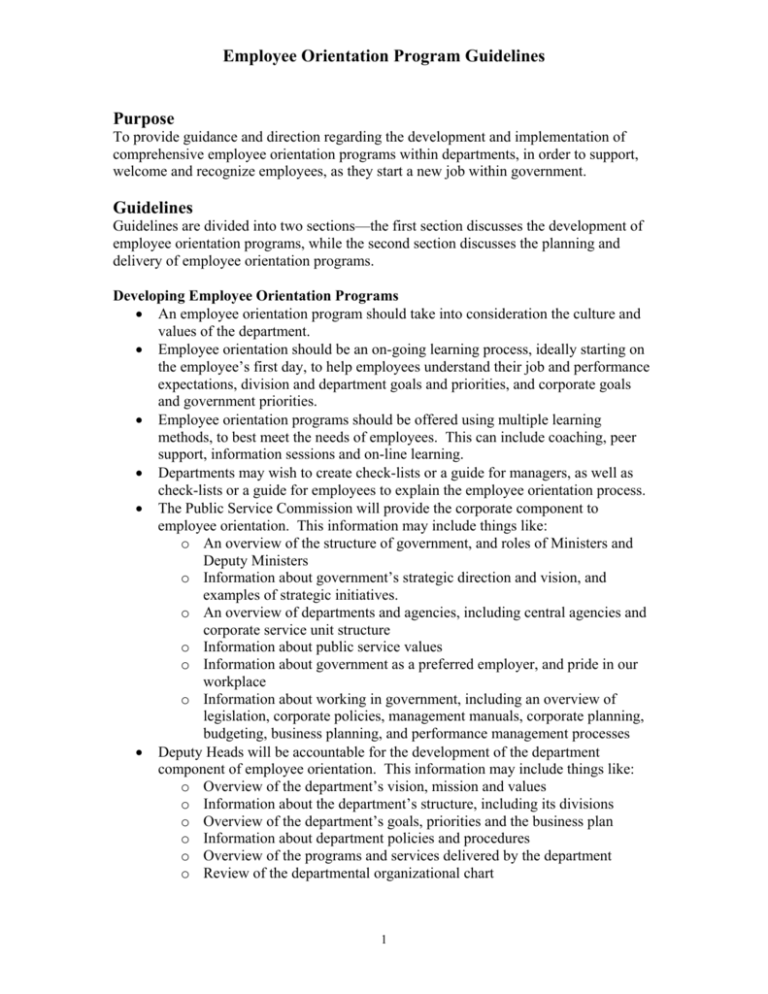
Employee Orientation Program Guidelines Purpose To provide guidance and direction regarding the development and implementation of comprehensive employee orientation programs within departments, in order to support, welcome and recognize employees, as they start a new job within government. Guidelines Guidelines are divided into two sections—the first section discusses the development of employee orientation programs, while the second section discusses the planning and delivery of employee orientation programs. Developing Employee Orientation Programs • An employee orientation program should take into consideration the culture and values of the department. • Employee orientation should be an on-going learning process, ideally starting on the employee’s first day, to help employees understand their job and performance expectations, division and department goals and priorities, and corporate goals and government priorities. • Employee orientation programs should be offered using multiple learning methods, to best meet the needs of employees. This can include coaching, peer support, information sessions and on-line learning. • Departments may wish to create check-lists or a guide for managers, as well as check-lists or a guide for employees to explain the employee orientation process. • The Public Service Commission will provide the corporate component to employee orientation. This information may include things like: o An overview of the structure of government, and roles of Ministers and Deputy Ministers o Information about government’s strategic direction and vision, and examples of strategic initiatives. o An overview of departments and agencies, including central agencies and corporate service unit structure o Information about public service values o Information about government as a preferred employer, and pride in our workplace o Information about working in government, including an overview of legislation, corporate policies, management manuals, corporate planning, budgeting, business planning, and performance management processes • Deputy Heads will be accountable for the development of the department component of employee orientation. This information may include things like: o Overview of the department’s vision, mission and values o Information about the department’s structure, including its divisions o Overview of the department’s goals, priorities and the business plan o Information about department policies and procedures o Overview of the programs and services delivered by the department o Review of the departmental organizational chart 1 Employee Orientation Program Guidelines o Information about human resources initiatives for employees, such as healthy workplace, diversity, learning and development, and employee recognition activities o Information about employee benefits and pensions o Information about Employee Self-Serve (ESS) • Managers will lead the development of the job-specific component to employee orientation. This information may include things like: o Overview of the position description and job posting o Information about roles and responsibilities, goals, and priorities of the division and the employee’s work unit o Introduction to key contacts and team members o Information about work assignments, client groups (if appropriate), etc. o Information about the terms and conditions of employment, including a discussion about probationary periods, work hours, etc. o Review of performance management cycles for the division, including performance review timelines o Review of applicable dress code o Tour of work space o Equipment orientation and training o Occupational Health and Safety (OHS) information o Review of security procedures o Review of acronyms and common terminology used in the work unit o Information about mandatory training for the position Planning and Delivering Employee Orientation for a New Employee The information in this section is directed to managers and supervisors, and can assist the implementation of employee orientation activities. Answers to the questions outlined below can help managers or supervisors plan the employee’s orientation and anticipating their learning needs. • What is the employee’s employment background? (Within the Government of Nova Scotia, public sector outside of the Government of Nova Scotia, private sector, non-profit, within province/out of province, etc.) • How long is the employee with you (permanent, temporary, casual basis)? • What do they need to know to perform best in their role? • Who do they need to know to perform best in their role? • What resources (internal/external) are available for the new hire? • Is there something unique about your department and/or work team? Suggested activities have been outlined below, divided into four phases: prior to the employee’s first day, the employee’s first day on the job, the employee’s first week on the job, and the employee’s first month on the job. Employee orientation should be an on-going learning process, so managers and supervisors are encouraged to use these 2 Employee Orientation Program Guidelines suggested timeframes and build on them as they see fit. In addition, consider the use of a “buddy system”, having a team member available to coach the new employee throughout the orientation process. Prior to the First Day Administration Follow-up with HR CSU to ensure that the offer letter has been sent and signatures have been obtained Contact the new employee to ensure that they are aware of the office’s location time to report to work on their first day office dress code parking/transportation options Update staff directories, organizational charts, distribution lists, schedules Obtain building keys, office keys, desk keys, any access passes as required Workspace Arrange workspace and furniture Consider conducting an ergonomics assessment Arrange for equipment set-up and training computer (obtain name, middle initial of new employee) phone printers and any other equipment Ensure workspace equipped with appropriate reference materials and stationary supplies Introductions Ensure that you are available to meet the new employee ideally on their first day Introduce the new employee to the organization by e-mail Ensure the immediate team and security staff are aware of the new employee’s start date Set-up welcome meetings with head of the department/agency Set-up meetings with immediate team members to discuss work functions. Work Assignments Identify team Schedule any relevant meetings for the first 2 weeks Coordinate initial assignments/projects Employee’s First Day Manager or supervisor meets with the new employee to: review the employee orientation process and discuss plans for the day/week 3 Employee Orientation Program Guidelines review the position description, job posting, and discuss performance expectations (expected outcomes for the position) review of hours of work, dress code, flexible work arrangements (if applicable) review security processes, including access cards, codes, keys review information on office hours, building opening and closing hours, after hour entry/exit process identify location of washrooms, lunchrooms, common areas, mail room, library, stationary cupboard, etc.. identify fires exits, first aid kit, OH&S information board, OH&S department representative, first aid attendant review computer and telephone set-up, use and protocol review Groupwise email system and protocols provide staff directory discuss any pertinent office procedures (vacation coverage, calling in sick, office supplies, etc.) direct to department and government website identify team member who will assist in the orientation and key departmental contacts review Corporate Employee Orientation Program, including the online learning tool Introductions to employees in the work unit and division Complete forms and receive benefit and pension information Obtain Government ID Submit personal information for the employee record in the HR information system, SAP-HR Complete HR Information Form Complete Payroll Direct Deposit Enrollment Form Complete Federal and Provincial Income Tax Forms Complete Statement of Previous Service Complete Province of NS Application for Group Benefits (health & dental) Complete Basic Group Life Enrolment and Optional Group Life Assurance Application Complete Employee Self-Identification Survey (voluntary) Review Employee Self-Serve (ESS) First Week Review department organizational structure Review CSU contacts Introduction to EAP Introduction to OH&S (safety procedures, emergency evacuation, incident reporting, first aid) Introduction to LearnNet, the corporate online learning calendar for training registration– set up account 4 Employee Orientation Program Guidelines Arrange a welcome meeting with department’s senior leader (Deputy Minister, Executive Director) if not done on the first day. Arrange brief appointments with senior management team for a welcome and review Arrange appointments with specific employees in the division to give an overview of complementing functions within the division. Review acronym dictionary Review department and government internet/intranet sites Review government policies Review government contacts and resources Review administrative practices Order business cards and nameplate for the new employee First Month Review goals, objectives and work plans Introduction to performance management system Set-up a meeting to formally check-in with the new employee Complete performance management plan and career path form with manager Schedule probationary performance evaluation Discuss and schedule mandatory training; consider other relevant training and development needs Meet with clients, stakeholders, etc. Evaluate orientation program A Note about Temporary Employees and Students At a minimum, temporary and student employees should receive an overview of their role and responsibilities, the department’s role and responsibilities, relevant department policies and procedures, and health and safety information. Their orientation should also include an overview of the physical location, and an introduction to immediate workgroups and key stakeholders. In addition, these employees can be directed to any on-line or hard copy resources provided by the department and the Public Service Commission for self-directed learning. 5
